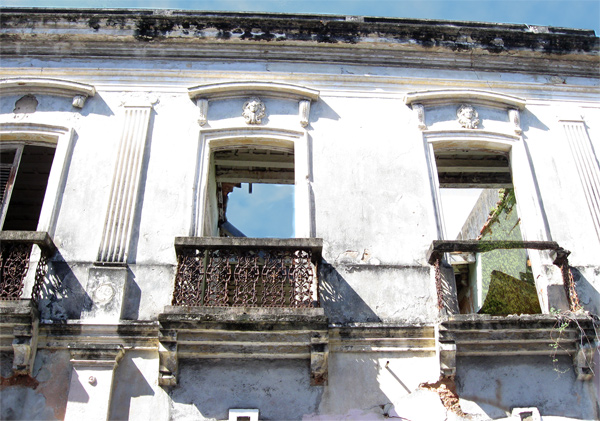
Yesterday it housed people; today it houses birds and vines.
“What is a ruin but time easing itself of endurance?” – Djuna Barnes
Ruins are fascinating. This is where you begin to see the layers of time working each other. Like the cross-section diagrams that still fascinate me – if you’ve ever read David Macaulay’s books Underground, Cathedral, City, Castle and Unbuilding, then you know what I’m talking about – a ruin reveals the infrastructure behind the skin, the processes behind the world.
In Stewart Brand’s excellent book The Clock of the Long Now: Time And Responsibility, he speaks of the six layers of society, and how each one operates at a different speed. His layers, from fastest to slowest, are art/fashion, commerce, government, religion, culture, nature. You can quibble with his classifications, but it’s not hard to see his logic. The layers are interlocked, each informing the others. When societies function reasonably well, people are able to live decent lives, and feel like they’re contributing to and being supported by the different layers. When societies malfunction (as often happens) – when commerce drives our lives and bends them to its will, or when religious dogmatism stultifies innovation – the resulting friction between layers ruins lives.
Theorists like Deleuze and Guattari, and their latter-day descendant Manuel DeLanda (and predecessors Marx and Smith, to mention a few), go into enormous detail about this. But much of what they have to say may come off as too abstract, until you look at a ruined building, and see the concrete reality. A ruin was once a building, in some ways the perfect handshake between art (fast) and culture (slow). The buildings that survive long enough to be ruins sheltered that which the society that built them valued the most. Cathedrals and pyramids, castles, mansions. It’s not hard to see what will survive this era. The giant concrete and steel edifices of Wall Street will – long after the glass has cracked and the cubicle walls rotted by moss – one day be what factories look like today: shells that once spoke of thunderous activity pursuing what looked like a glorious, permanent future. The ruins were often built by people who could never have afforded to live in them. How many peasants died to put up the walls of Uruk? How many slaves built the turrets in Troy? Whose bones are buried near Macho Picchu? The futures these buildings speak of never came to be.
Often, it’s the art – that most impermanent of things – that tells us the most about who lived and died there. The wall with inscribed/painted stories; the sculptures that adorn the weedy lawn; the adornment on commonplace cups, bowls and tools. The money is now worthless; the laws outmoded; the culture mutated (often to the better, sometimes for the worse) by invasions, migrations, modernization; the gods have been usurped, expunged outright, or re-purposed by the next upstart religion; even the language of the descendants would be unrecognizable to a time traveler from the heyday of the building’s use. What’s left is the bones, and the skin.
But ruins are far from dead. Nature turned railways into gardens long before some real estate developers figured out the trick. The grandchildren of the peasants who lived in fear of the strongmen in the castle use its bricks and stone to build their houses. The cathedral becomes a nightclub. The old factory is now an artists’ colony (and, sadly, soon will be a trendy shopping center). In a ruin you can see the layers of time part like vellum transparencies in an anatomy textbook. You can see possibilities, edges, mortality. You can see the future from the altars they prayed to – and preyed upon from – in the past. You can see threads of hope and resistance, often in the graffiti and in the nooks that the officials didn’t care about. Most of all you can see life continuing to thrive.
